Morris & Fan. Reservoir Sedimentation Handbook
Подождите немного. Документ загружается.

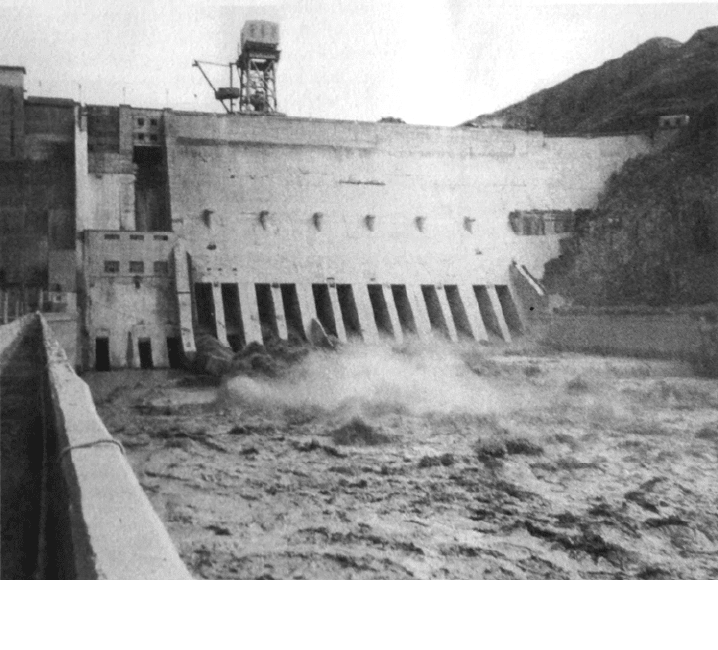
CASE STUDY: SANMENXIA RESERVOIR 24.6
FIGURE 24.4 (b) Downstream face of Sanmenxia Dam during sediment flushing showing flow
exiting from the sediment sluices (G. Morris).
The effectiveness of sediment control achieved at each stage of reconstruction
was analyzed and used as the basis for designing the next stage improvements. Sediment
inflow and outflow were brought into balance during the fourth stage, and
subsequent work focused on increasing project benefits while maintaining the sediment
balance across the impounded reach. The six stage of dam reconstruction and
operation to date are outlined in Table 24.3 and are described in more detail below.
Stage 1. Impounding began in September 1960. According to the original project
design, the dam was intended to maintain a pool elevation of 340 m for
multipurpose benefits, but serious deposition was already occurring when the
water level reached 335.5 m. Six months after closure, sediment accumulation
caused backwater effects to extend upstream about 250 km from the dam, that is,
136 km upstream from Tongguan, and the bed elevation at Tongguan rose by 4.5 m.
The floodplain adjacent to the downstream reach of the Wei River is an important
agricultural area, and the industrial area of Xian is situated on the south hank of
the Wei River about 150 km upstream of Tongguan. It was realized that both
would be partially flooded because of backwater deposition if sedimentation were
not controlled.
Stage 2. Reservoir operation was changed after 1962 to maintain lower water levels
year-round by using the outlets at 300 m contained in the original design, but the rate
of deposition was still high because the outlet capacity was too small and the
elevation was too high for efficient sediment release. An additional 3.39×10
9
tons
of sediment had deposited by June 1966. The original design did not have
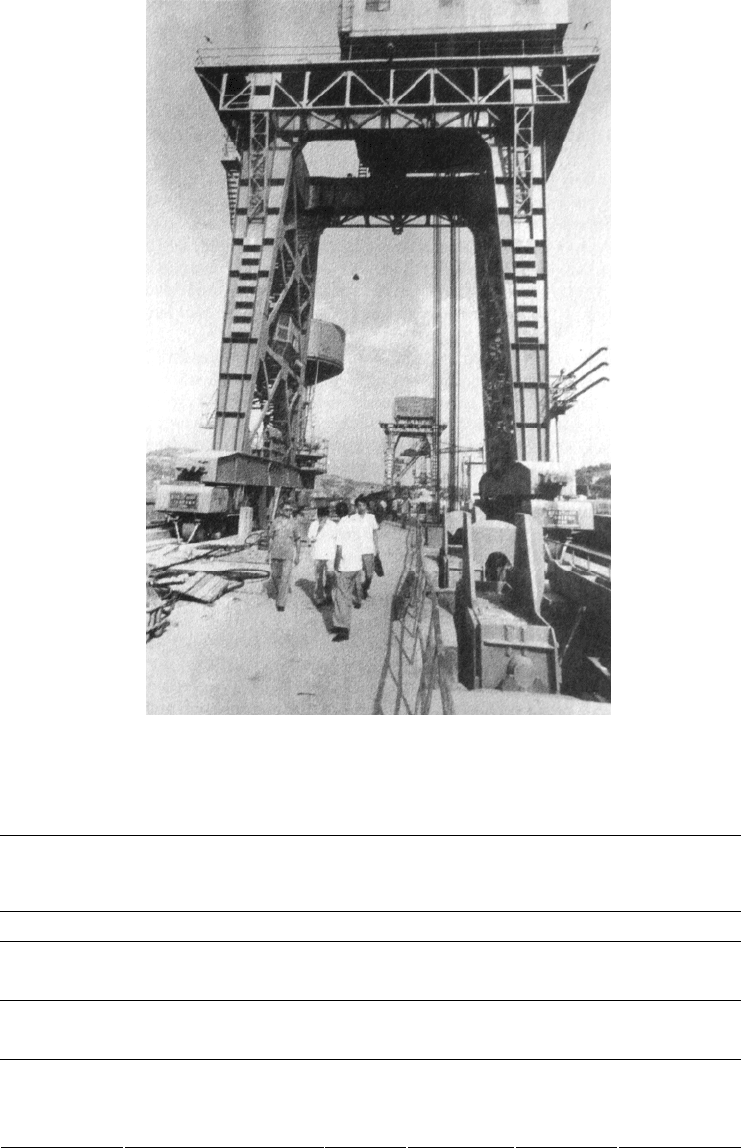
CASE STUDY: SANMENXIA RESERVOIR 24.7
FIGURE 24.5 Vertical sluice gate (right foreground) and gantry for gate placement.
(G. Morris).
TABLE 24.2 Outlets in Sanmenxia Dam
Outlet Dimensions
Total
number
Serial
number
Invert
elevation,
m
Starting
year of
operation
Deep sluices 3 x 8 m 12 1-12 300 1960
Penstock Diameter = 7.5 m, 1 5 287 1966
sluices* exit gate 2.6 x 3.4m 3 6-8 300 1966
Tunnels Diameter = 11m, 2 1-2 290 1967 and
8 x 8 m radial gate 1968
3 1-3 280 1970
5 4-8 280 1971
Bottom
sluices
3 x 8 m
2 9-10 280 1990
*Penstocks 5 through 8 were converted to discharge floodwater in 1966. Penstocks 5 was converted back to
power generation in 1978.
Source: Shaanxi Provincial Institute of Hydraulic Reaserch and Qinghua University (1978).
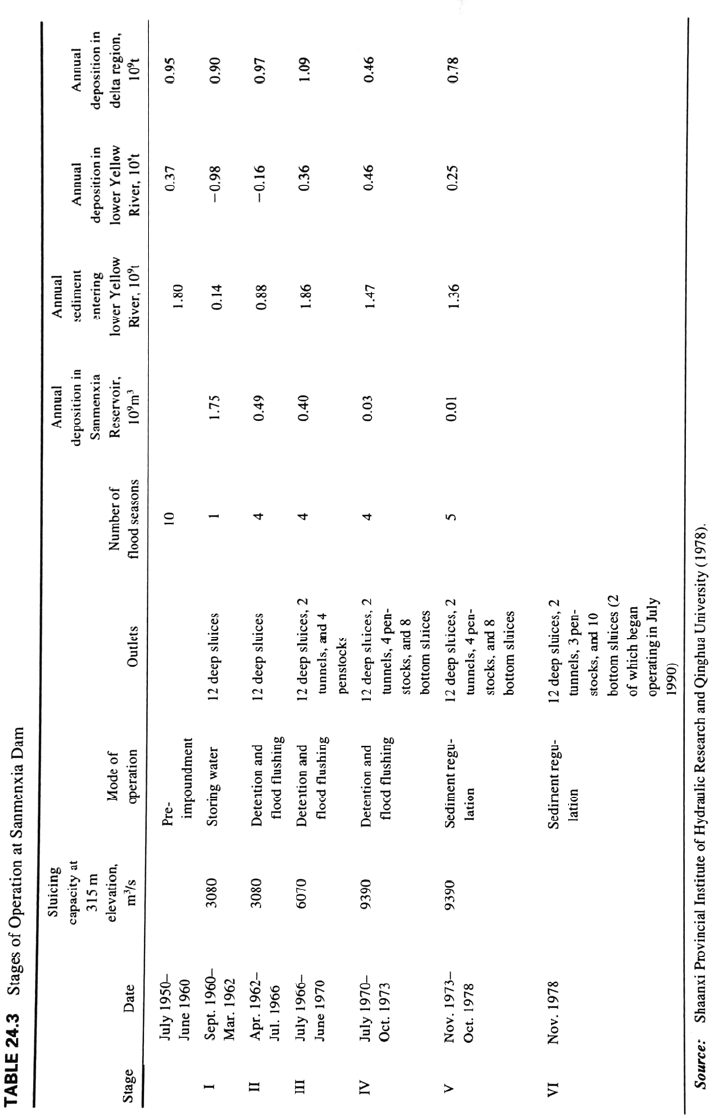
CASE STUDY: SANMENXIA RESERVOIR 24.8
CASE STUDY: SANMENXIA RESERVOIR 24.9
adequate sluicing capacity to prevent backwater during flood periods, and it became
evident that greatly increased low-level sluice capacity would be required to control
the bed elevation at Tongguan. Enhanced sluicing would also decrease the
degradation in the Yellow River below the darn, which was now suffering from the
reduction in sediment supply caused by the darn.
Stage 3. Additional sluicing capacity was provided by excavating two 11 m
diameter bypass tunnels around the left abutment of the darn with an invert elevation of
290 m, and controlled by 8 x 8 m radial gates. Four of the eight power intakes were
converted to sediment sluices and the pool level was lowered during the flood
season. These measures increased the release efficiency to 82.5 percent, but the bed
elevation at Tongguan was not lowered and deposition in the lower Wei River was
still serious. It was determined that additional low-level sluicing capacity was required.
Stage 4. In the fourth stage of reconstruction, eight of the original twelve river
diversion outlets at elevation 280 m, used for river diversion during dam construction
but subsequently filled with concrete, were reopened with jackhammers and
blasting. Reservoir operation was changed to flood detention and sediment sluicing;
all outlets remained continuously open and the dam acted as an uncontrolled detention
reservoir. The addition of bottom sluice capacity allowed lower pool levels to be
maintained during the flood season, resulting in a net removal of sediment by
scouring out some of the deposits. Sediment release efficiency reached 105 percent
of inflow, and the bed elevation at the Tongguan control section fell by nearly 2 m. In
1973 five generating sets of 50 MW each were installed, replacing the eight original
125-MW units. This represented less than one-quarter the design generating
capacity, a result of lower pool elevation and conversion of some penstocks to
sediment sluicing.
Stage 5. After sediment balance had been achieved and the bed elevation was
under control at Tongguan, reservoir operation was modified to increase project benefits
by impounding clear water during the nonflood season and releasing muddy water by
drawdown flushing during the flood season. As currently operated, all outlets are
opened and the reservoir is emptied starting in July, the beginning of the flood
season, allowing riverine flow to occur along the length of the impoundment for the
purpose of sediment pass-through routing and flushing. High-capacity bottom sluices
allow the pool elevation to be maintained at a low level during the flood season,
minimizing backwater deposition at Tongguan and thereby restricting further
upstream deposition in the Wei River. The history of bed elevation at Tongguan is
shown in Fig. 24.6.
Impounding part of the year provides water for irrigation, hydropower, and ice jam
control. Sediments deposited in the channel during the nonflood season are
scoured from the reservoir by high discharges at low pool elevations during the flood
season. Sediments flushed from the reservoir during the flood season are
transported downstream by higher discharges than were possible before dam
reconstruction. This mode of operation not only minimizes deposition within the
reservoir, it also increases sediment transport capacity in the Yellow River downstream
of the dam, and avoids the deposition of released sediment downstream of the darn.
Stage 6. Serious abrasion in the bottom outlets was repaired, decreasing the cross-
sectional area of outlets and reducing low-level sluicing capacity. To compensate,
two additional bottom outlets were opened and began operating in July 1990 to
increase discharge capacity. Generating units were installed in two penstocks previously
used for sediment sluicing. to increase power production. The reopening of the last
two bottom outlets is presently being considered to further increase discharge capacity.
Since 1980, hydropower generation has been halted during the flood season to
avoid turbine abrasion by high sediment concentrations.
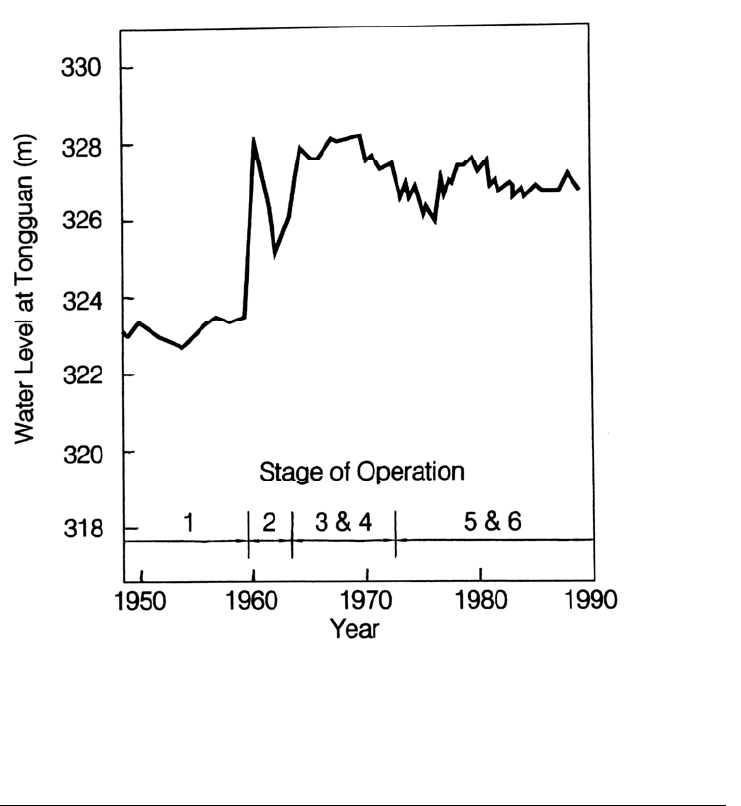
CASE STUDY: SANMENXIA RESERVOIR 24.10
FIGURE 24.6 Variation in water level at Tongguan at a discharge of 1000 m
3
/s, showing the impac
t
of dam construction and operation on bed elevation. The variation in water surface at a given
discharge is used to represent the variation in bed elevation because continuous bed measurements
were not taken (after Pan, 1990).
24.4 SEDIMENT MANAGEMENT FEATURES
24.4.1 Deposition and Flushing
The longitudinal pattern of sediment deposition is illustrated in Fig. 24.7, which shows
the rapid buildup of sediment along the entire length of the reservoir after closure. Rapid
deposition near the dam was caused by three factors: (1) high inflow sediment load. (2)
turbidity currents transported sediment-laden water to the vicinity of the dam during
periods of high pool elevation, and (3) limited reservoir drawdowns scoured sediments
from the upstream area of the impoundment, which were redeposited closer to the dam
upon encountering the backwater pool. At times the scoured sediments also plunged and
formed a turbidity current which deposited sediments near the dam.
During impounding, sediments are deposited along the main channel and also on the
submerged floodplain. Flushing flow scours the main channel and removes new deposits
from this area, but does not remove sediment from the floodplain. Sediments deposited in
the main channel are scoured during each subsequent flushing operation, but sediments
deposited on the submerged floodplain accumulate continuously. The strategy used at
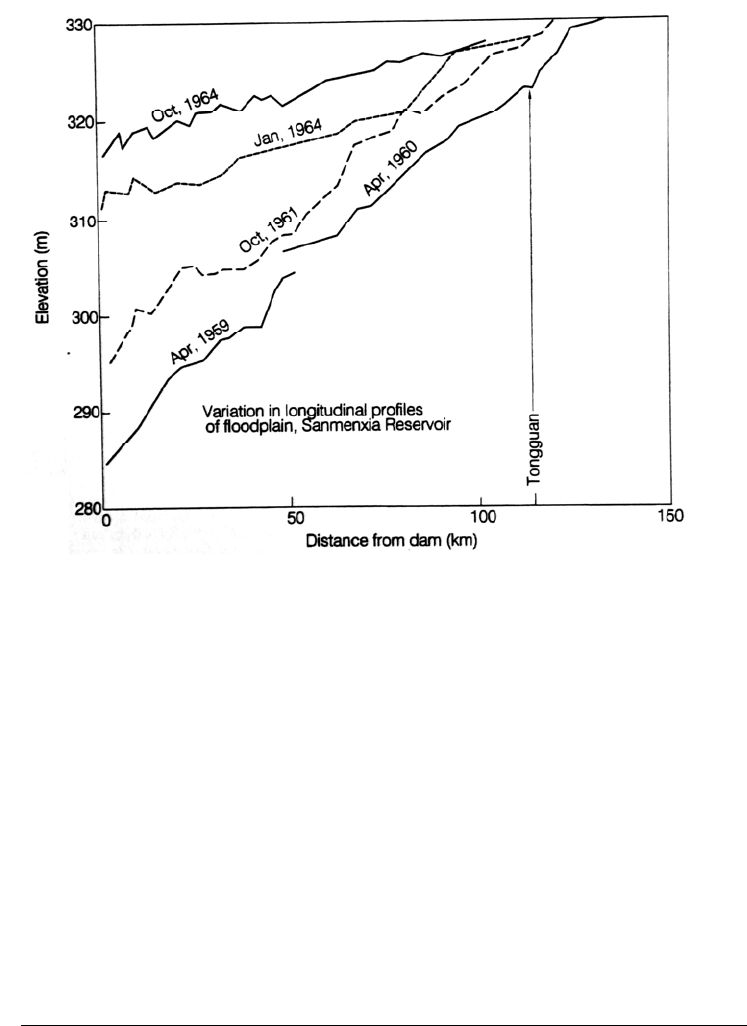
CASE STUDY: SANMENXIA RESERVOIR 24.11
FIGURE 24.7 Longitudinal floodplain profiles in Sanmenxia Reservoir (after Fan, 1985).
Sanrnenxia was to provide low-level outlets large enough to discharge sediment-
transporting floods through the dam with minimum backwater, only rarely inundating
the floodplain with sediment-laden flood water. The profile in Fig. 24.8 shows that
thalweg deposits attained depths exceeding 20 m near the dam between 1960 and 1964,
but by 1973 the pre-impoundment thalweg profile had been reestablished as a result
of reopening of low-level outlets and seasonal flushing. As the reservoir is operated
today, impounding begins and the floodplain is inundated starting at the end of the flood
season in October, when suspended-solids concentrations are lower and little sediment
accumulates on the submerged floodplain. The historical effect of this operation on
storage capacity was summarized in Fig. 24.2, which showed that storage capacity in
the main channel area was increased by flushing at the same time that storage continued
to decline in the floodplain area.
24.5 DELTA DEPOSITION AND EROSION
Siltation occurs in both longitudinal and transverse directions to form a reservoir delta or
submerged floodplain at the upstream end of the backwater reach created by a dam.
After closure in 1960, the delta started to form and advanced downstream toward the
dam. Figure 24.9 illustrates the cross section changes at Range 35 in Sanmenxia
Reservoir during the building of deltaic floodplain deposits. Range 35 is 90.2 km
upstream of the dam, at a point where the river gorge widens from an upstream section
only a few hundred meters in width.
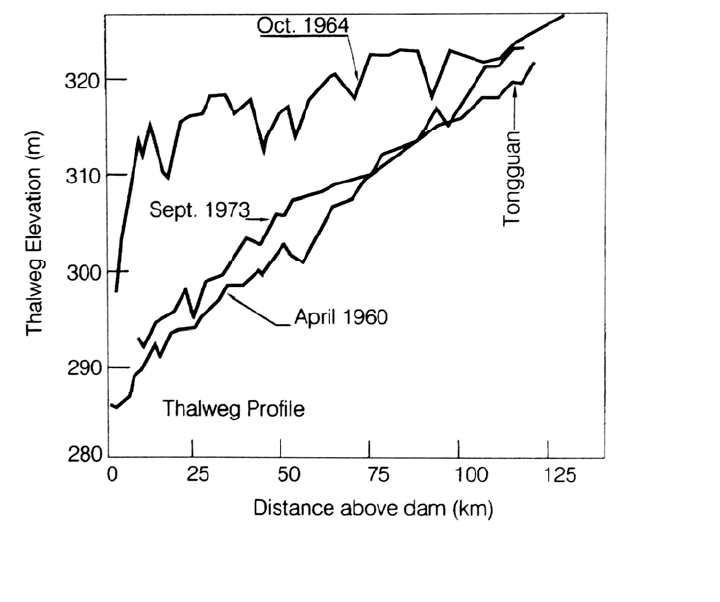
CASE STUDY: SANMENXIA RESERVOIR 24.12
FIGURE 24.8 Thalweg profiles in Sanmenxia Reservoir showing the rapid deposition o
f
sediment along the entire length of the reservoir, particularly near the dam, and reestablishment o
f
the pre-impoundment profile by flushing (after Fan, 1985).
Fro
m July 17 through August 8, 1961, the river discharged at a rate of 2200 to
4760 m
3
/s into range 35 which, at that time, was about 2 m deep and 1500 m wide. In
response to both siltation and scour, by August 8 a submerged floodplain more than
1200 m wide had been created and a main channel had been scoured that was less
than 300 m wide and over 4 m deep. The successive measurements at range 35
suggest that, in addition to moving longitudinally, sediment also moved laterally
from the main channel and onto floodplain deposits. Cross-section measurements
on August 5 show the formation of a natural levee. suggestive of the lateral
movement of sediment from the main channel onto the floodplain. Isolines of
sediment concentration (Fig. 24.10) exhibit a gradient that decreased laterally
from the main channel onto the floodplain.
While the dam was still under construction in 1959 and the 12 diversion
outlets at 280 m were being used to release floodwater, the backwater pool extended up
to 40 km above the dam. During this period, the area between 30 and 40 km
upstream of the dam was subject to alternating episodes of delta deposition
followed by scour. High-water levels during the July-August flood season
caused deposition to concentrate at the upstream end of the pool, but during the
low-flow period both discharge and water level decreased and scoured the
previously deposited material. Erosion occurred in most parts of the reservoir
during low-flow periods, and the entrainment of sediment from the bed caused
sediment concentration in the discharge to exceed inflow. Cross sections
measured during the depositional and erosional phases are presented in Fig.
24.11. Unlike cross sections from reservoirs which are subjected exclusively to
depositional processes and which consequently have a flat bottom, these cross sections
exhibit the development of the main channel and floodplain configuration typical of cross
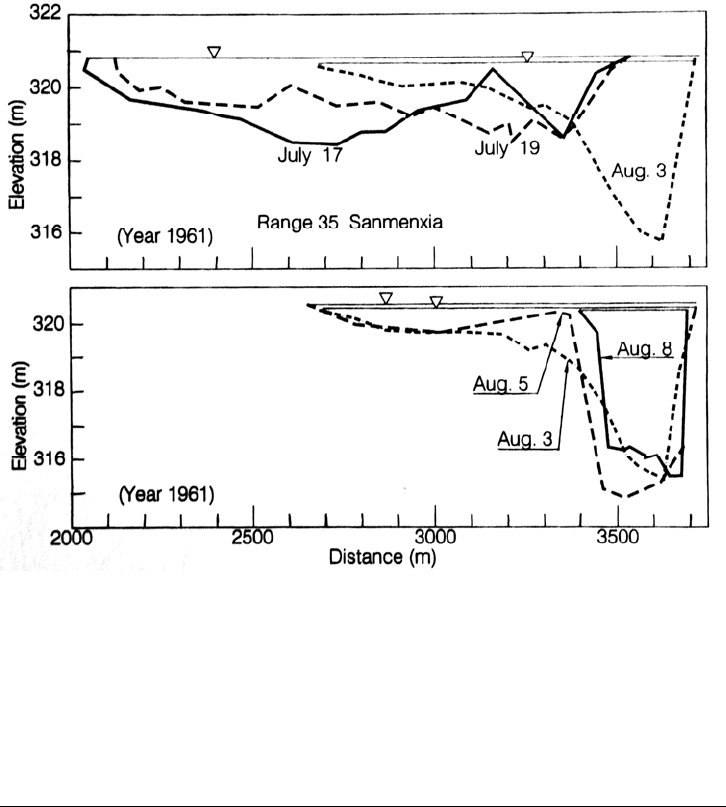
CASE STUDY: SANMENXIA RESERVOIR 24.13
FIGURE 24.9 Cross-section changes at range 35 in Sanmenxia Reservoir during
building of deltaic floodplain deposits (Fan and Morris. 1992a).
sections affected by alternating periods of deposition and scour. This pattern was absent
o
nly in the narrower reaches where the scour channel extended across the full width of
the reservoir.
24.6 TURBIDITY CURRENTS
Extensive measurements of flow patterns in turbidity currents at Sanmenxia
documented the transition from nonstratified flow, propagation along the length of the
reservoir, velocity and sediment concentration profiles at different stages and
discharges, unsteady flow characteristics of turbidity currents, timewise variation in the
location of the clear-muddy water interface, and the venting efficiency of turbidity
current release through low-level outlets (Fan, 1985, 1986, 1991). Turbid density
currents, including data from Sanmenxia reservoir, are discussed in Chap. 14.
Turbidity currents first occurred in the backwater reach prior to completion of the dam. The
longitudinal profile of a turbidity current along a 65-km impounded reach, caused by the
plunging of river inflow having a high suspended-sediment concentration, is summarized in
Fig. 24.12. The figure shows the transition of inflow to stratified flow downstream of the
plunge point, travel along the reservoir, and the creation of a muddy lake between Range 12
and the dam site. A different situation was observed on July 30, 1962, when the reservoir
was at a low water level of 314 m, creating a 40-km impounded reach. In this case, the
river inflow was not highly turbid, but reservoir drawdown caused the river to scour and
entrain previously deposited sediment between Ranges 31 and 41, thereby creating high
sediment concentrations and a turbid current that was vented through the dam. This
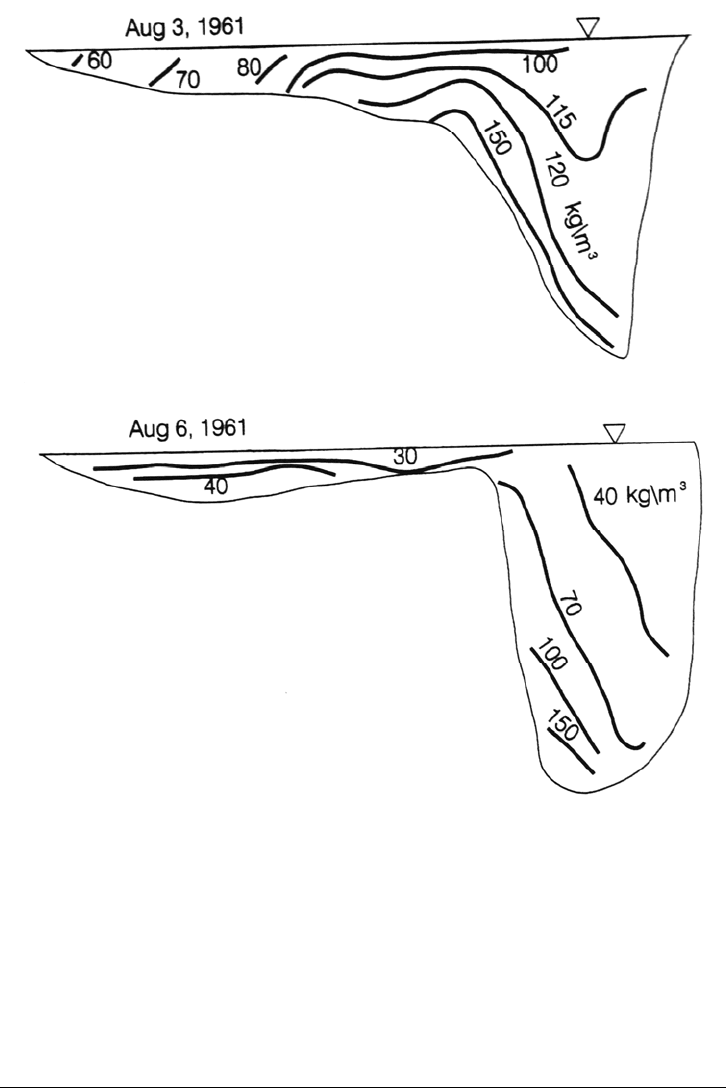
CASE STUDY: SANMENXIA RESERVOIR 24.14
demonstrated that a turbidity current may be created by the entrainment of previously
deposited sediment during reservoir drawdown, even when inflow conditions would not
otherwise have produced flow stratification. Thus, during reservoir drawdown, turbidity
currents may be created within the impounded reach, independent of the sediment load
contributed by the river.
FIGURE 24.10 Concentration isolines for suspended sediment showing a gradient that decrease
d
laterally from the main channel to the floodplain (Fan and Morris, 1992a).
24.7 DEPOSITION ALONG WEI RIVER
Historical data from the Wei River indicate that the river channel along the lower reach
had remained in a state of quasi-equilibrium for more than 2000 years before dam con-
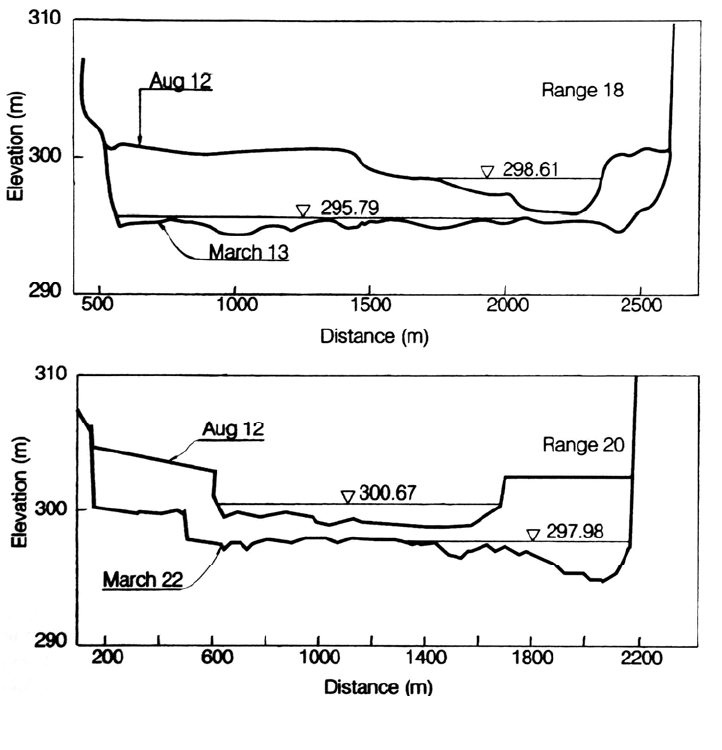
CASE STUDY: SANMENXIA RESERVOIR 24.15
FIGURE 24.11 Development of channel and floodplain configuration in Sanmenxia Reservoi
r
(Fan, 1985).
struction. Archaeologists discovered sediment deposits less than 1 m deep overlying
wells built in the Qin Dynasty (221-206 B.C.) on the floodplain of the Lower Reach of
the Wei River. Before dam construction the bed material in the Lower Reach of the Wei
River consisted of sands, with fines being transported as wash load. Because the
confluence of the Wei and Yellow Rivers is only a few kilometers upstream of
Tongguan, sediment deposition and backwater at Tongguan affect the Wei River. The
upstream limit of sediment deposition during floods historically shifted over a distance of
tens of kilometers along both the Wei and Yellow Rivers in response to alternating
deposition and scour events and the stage at Tongguan. Following dam construction,
three conditions caused serious deposition upstream along the Wei River: (1) backwater
from the dam, (2) upstream movement of turbid density currents from the Yellow River,
and (3) deposition from a sediment-laden tributary, the Luo River, as located in Fig. 24.1.
24.7.1 Backwater Deposition
Backwater from the dam caused sediments transported along the Wei River to settle as
far as 250 km upstream of the dam during the initial impounding period, as illustrated
